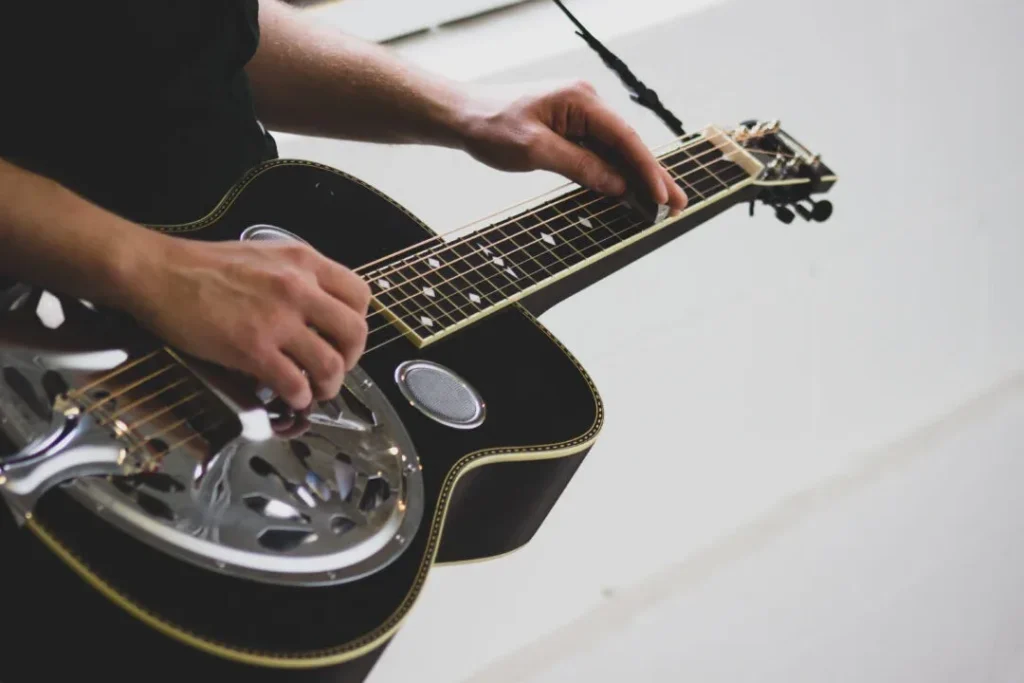We sat down to get to know a little about Alex Sens and an instrument called the dobro.
Alex will be teaching dobro at Ashoksn’s upcoming Bluegrass Camp as well as leading classes on the art of jamming. He has been playing and teaching the dobro for 40 years and is a mainstay of the bluegrass scene in Washington, DC.
How did you get into playing dobro?
Alex: I played guitar as a kid, and I always sort of wanted to take up the banjo. But when I was a freshman in college, one of my good friends down the hall had this amazing record collection. He’d grown up in DC, and one of his favorite records was “Seldom Scene: Live at the Cellar Door,” which was recorded at a music (now sadly, a Starbucks) about a block from where I spend most of my weekdays. I was just blown away by Mike Auldridge’s dobro—I don’t think I’d ever heard anything so lyrical and cool. Pretty soon thereafter I heard Jerry Douglas, and I was obsessed. So I bought an inexpensive one and spent hours and hours that summer trying to figure it out—back then there weren’t online resources and very little in print. Eventually, I made friends with a dobro-player at the Berkshire Bluegrass Festival in 1987, and I’d make a six-hour drive every few months from Boston to his home in South New Jersey for lessons that would go on for hours. It’s been a wonderful journey!
What is the dobro? Vs a lap slide w or w/o a resonator?
Alex: A fun fact about “dobro” as a term is that it started its life as a brand name and got generalized, like “Kleenex.” Technically it’s a “resonator” or “resophonic” guitar, but pretty much everyone just says dobro. The concept for the instrument was imagined by the Dopyera brothers (hence, ‘do-bro”) in the 20s. One of the brothers, John, had previously been a principal of the National String Instrument Corporation, which aimed to produce steel guitars that could hold up against louder instruments. What we think of as a dobro now is basically a wooden guitar that has a single spun aluminum cone suspended on a metal frame where the sound hole would be on a guitar. That, and the internal guts of the thing, create the resonant tone. But even now builders continue to innovate on the basic design
The Dopyeras and their successors also made round necked guitars to play Spanish style, but when we refer to a dobro in a bluegrass context we’re referring to a square-necked guitar played lap style with a metal part. There are other types of guitar played this way, including Hawaiian-style acoustic guitars like the Weissenborn and Kona, metal-bodied acoustic guitars, and electrified lap steels.
Is it easy to pick up if you have played guitar?
Alex: Although there are differences, the dobro will be conceptually familiar to guitar- and banjo players. It’s an accessible instrument, but of course like all instruments it has its challenges—in the case of the dobro, the quest for tone and cleanliness is something I still spend a lot of time on after 40 years. I like to tell students that the simplicity of the instrument—the fact that it’s played in open tuning with a bar that sort of acts like a single finger—is both a blessing and a curse. It means that you can start playing with others very quickly, but you have to be creative to play things other than major chords.
In bluegrass, the dobro is typically tuned to open G (GBDGBD from low to high) but sometimes also D (DAF#DAD), which gives more bottom end and really sounds great for blues. There’s a cool device on one of my instruments that allows me to switch back and forth easily
If you’ve played slide guitar tuned to an open chord, the dobro will be very familiar, as it will too if you’ve play banjo! Because of the position in which it’s played, the left and right hand techniques will be new to most people, but that’s all part of the fun!
What styles of music does the dobro work with best?
Alex: The dobro is great for accompanying singers—like the fiddle, its sustain makes it perfect as a complement to the human voice. But most often the dobro is used these days for bluegrass, blues or country music. One of my goals as a teacher is to give students enough material that they can understand the possibilities of the instrument, even if it takes a while for their technique to catch up.
What type of dobro do you play?
Alex: I originally played a few older guitars, Dobros and a successor brand called Regal, but in the 90s, Tim Scheerhorn and Paul Beard started making guitars with innovative designs and launched a whole new generation of builders. I played Scheerhorns for a number of years, but I sold them about 10 years ago and now have four Beard guitars, each very different. The one I’m currently obsessed with is maple and very open sounding.
Do you find any parallels between music and nature?
Alex: I’ve always loved being outside in nature, and it’s one of the places I feel most at peace and comfortable. For me, there’s a real similarity between the flow state you can get into playing music and the feeling I get of being one with the world when I’m out in nature.
Catch Alex at Ashokan’s Bluegrass Camp and Bluegrass Open House.

